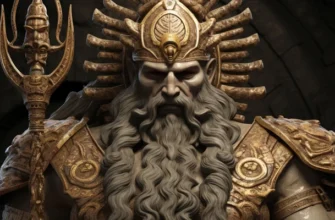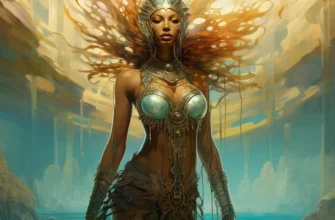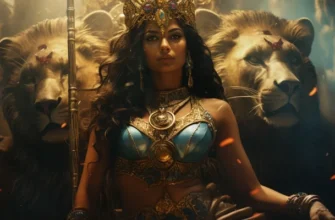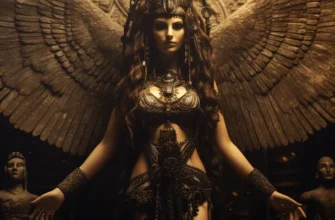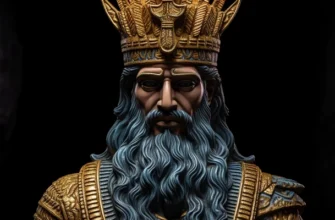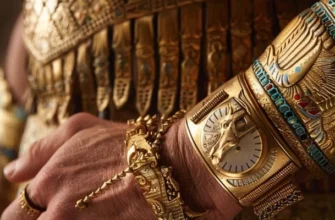Ninhursag is a prominent figure in Sumerian mythology. As the mother of all the gods, she is considered the creative force of life. Her cult is associated with healing power and protection of humanity. In Sumerian myths, Ninhursag is the image of a mother and a doctor who gives life and heals. This goddess embodies an important aspect of Sumerian religion and culture, her image impresses with its grandeur and influence on the perception of the world in the ancient East.
- The role of goddesses in the Sumerian pantheon
- Mythological origin of Ninhursag
- Legends and myths related to her creation
- Attributes and character traits
- Ninhursag’s role in the creation and maintenance of the world
- Religious rituals and holidays
- Iconography and symbolism associated with the goddess
- Modern perception and influence
- Modern beliefs based on the image of Ninhursag
- Historical context and archaeological findings
- References to Ninhursag in ancient texts and chronicles
- Conclusion
The role of goddesses in the Sumerian pantheon
The goddesses in Sumerian mythology played a key role in the creation and governance of the world. They represented the feminine aspect of the deity and acted as creative forces, mothers, and patrons. Goddesses played a key role in creating and sustaining life, and were important figures in rituals and festivals. Their interaction with the gods determined various aspects of cosmogony and socio-cultural life. Fertility, healing, and the general well-being of Sumerian society depended on the deification of the goddesses.
Mythological origin of Ninhursag
Ninhursag, the majestic Sumerian goddess, has a fascinating mythological origin. According to one legend, she emerged from the union of the celestial god Anu and the earth goddess Ki. Her birth symbolizes the union of the heavenly and earthly realms, defining her role as an important mediator between heaven and earth. The myth of her origins reveals the significance of Ninhursag as a goddess of creativity and life-giving power in the Sumerian pantheon.
Legends and myths related to her creation
According to Sumerian myths, Ninhursag arose from a divine union between the great celestial god Anu and the earth goddess Ki. This unifying act is a symbolic union of the heavenly and earthly worlds, which determined its unique character. The legend reveals not only her divine origin, but also her importance in the creation and maintenance of the universe, making her a key figure in the Sumerian pantheon.
For example, Sumerian myths often include epic poems and praise texts that reveal religious views and events. Some famous Sumerian works include the Enuma Elish (Divine Beginning), the Epic of Gilgamesh, and the Song of Inana, but they are not always directly related to Ninhursag or its creation.
In other cases, archaeological finds, such as cylinder seals and clay tablets, may contain illustrations or other images indicating the cult of the goddess, but the information may be limited and require detailed research and reconstruction.
In the Sumerian pantheon, Ninhursag occupied an important place among other gods. She was considered the mother of many other deities, including great gods such as Enlil (god of the sky), Enki (god of wisdom and water), and others. As the mother of the gods, Ninhursag wielded great power and authority in the Sumerian pantheon.
Her role as a creative force and mother of life gave her a special place in mythology. She was recognized as the protector of life, the patroness of motherhood, and a healer. Her interaction with the other gods determined the course of events in the Sumerian cosmogonic order and in human life. In many myths and rituals, she acted as an intermediary between the gods and humans, promoting harmony and well-being.
Attributes and character traits
The attributes and character traits of the goddess Ninhursag in Sumerian mythology give her a unique and important status in the pantheon. Some key attributes and character traits include:
Motherhood and Creative Power: Ninhursag was recognized as the mother of all the gods, giving her exceptional status as a creative force and source of life.
Medicinal Powers: The goddess was often associated with healing and medical aspects. Her cult was associated with healing powers, and she acted as a protector of health and a physician.
Patronage of Motherhood: Ninhursag was the patroness of motherhood and feminine aspects. She was venerated, in particular, by women seeking protection during pregnancy and childbirth.
Mediation between Heaven and Earth: As born from the union of the gods of heaven and earth, Ninhursag acted as a mediator between the heavenly and earthly realms.
These character traits and attributes determined Ninhursag’s importance as a deity who combined power and grace, creativity and patronage.
Ninhursag’s role in the creation and maintenance of the world
The role of the goddess Ninhursag in the creation and maintenance of the world in Sumerian mythology is manifested through several key aspects:
Creative Power: Ninhursag is considered to be the creative force because she emerged from the union of the celestial god Anu and the earth goddess Ki. Her birth marked the beginning of life and the world.
Motherhood: As the mother of all the gods, Ninhursag played an important role in the further development of the deities and the maintenance of their existence.
Mediating between Heaven and Earth: Her divine origin, which bridges the celestial and the terrestrial, makes her a mediator between the different realms of the world. This enhances her role in promoting harmony and interaction between heaven and earth.
Medicinal and life-giving functions: As a goddess of healing power, Ninhursag was intended as a physician with the ability to heal and revitalize. Her presence was noted for maintaining life and health.
Thus, in Sumerian mythology, Ninhursag is a key deity who ensures harmony and order in the world through her creative and maternal role.
Religious rituals and holidays
The existence of specific religious rituals and festivals associated with the goddess Ninhursag in the Sumerian pantheon can be difficult to determine due to the limited number of surviving information sources. However, given Sumerian religious and cultural practices, we can identify certain aspects that may have been associated with the cult of the goddess:
The Festival of Fertility and Harvest: There were probably rites and festivals aimed at ensuring fertility and prosperity in agriculture. The goddess of motherhood and fertility may have been the object of special rites for harmony with nature.
Rites of Motherhood and Childbirth: There were possible rites related to motherhood, pregnancy and childbirth, as Ninhursag was the patroness of motherhood. Women may have turned to her during these events for blessings and protection.
Healing Rituals: There may have been ceremonies and rituals aimed at glorifying the healing power of the goddess. People may have turned to Ninhursag in the hope of recovery and protection from illness.
Religious Rites at the Laying of the Foundations of a Cult: When temples or cult centers were founded, special religious rites may have been performed to honor Ninhursag and ensure her presence.
Holidays Related to World Comparisons:Some holidays and rituals may have been celebrated in comparison to other deities and cults to highlight Ninhursag’s role in a broader religious context.
In the absence of concrete sources, the exact nature of these rites and festivals remains a matter of hypothesis and the study of archaeological evidence. Festive events and rituals
Iconography and symbolism associated with the goddess
The iconography and symbolism associated with the goddess Ninhursag in Sumerian mythology can be identified through the various images and objects attributed to her. Some possible elements of iconography and symbolism include:
Headdress:The goddess is often depicted in rich and elaborate imagery, often with specific headdresses indicating her divine status.
Symbolism of Motherhood:Motherhood and feminine aspects may be celebrated by depicting Ninhursag along with symbols of motherhood such as a child or a pregnant woman.
Healing Instruments:Iconography may use images of objects associated with healing power, such as medicinal tools, herbs, or invocations to natural elements.
Mediation between Heaven and Earth:Images that emphasize her role as a mediator between heaven and earth may include symbolism that combines elements of both realms.
Feminine Symbols:Elements such as symbols of femininity, such as makeup or jewelry, may emphasize her feminine aspect.
Modern perception and influence
The modern perception and influence of the Sumerian goddess Ninhursag is determined mainly by scholarly and cultural discourses. Since this deity has roots in ancient mythology, her role in the modern world is mainly reflected in scientific research, art, and educational initiatives. Here are a few aspects:
Academic Research:Ninhursag, like other deities of the Sumerian pantheon, is the object of academic research in the fields of archaeology, mythology, and religious studies. Contemporary scholars explore various aspects of her cult and history.
Artistic Reproduction:Artists and creators can use images of Ninhursag in their works as a source of inspiration. Recreating the deity in contemporary art can provide a new context of interpretation.
Promotion on the Internet:Knowledge about Sumerian mythology and the goddess Ninhursag can be reflected in online communities, blogs, video content, and other online resources where fans and researchers exchange information and opinions.
Educational Programs:Sumerian mythology, including figures such as Ninhursag, can be incorporated into educational programs in the history of religions or ancient history, providing students with opportunities to explore religious practices and beliefs.
Although contemporary perceptions of the goddess Ninhursag are varied, her influence and significance are mostly found in scholarly and cultural contexts where her story and role can serve as an object of research and discussion.
Modern beliefs based on the image of Ninhursag
The Sumerian goddess Ninhursag and her image are not the subject of modern organized religious cults or beliefs. Modern religions are usually based on their own holy texts and deities, and do not use images from ancient pantheons such as the Sumerian one.
However, the images and symbolism of ancient deities, including Ninhursag, may be of interest to individuals who study ancient mythology or have an interest in archaeology and the history of religions. This interest can be expressed in scientific research, art, or simply in personal exploration and development.
In the modern world, there are many individuals who study ancient religions and mythology from the perspective of archaeology or religious history. However, this is not part of modern official religious cults.
Historical context and archaeological findings
The historical context and archaeological findings are related to the Sumerian goddess Ninhursag, who existed in ancient Mesopotamia. Here are some aspects of this context:
Place and Time:The Sumerian civilization was located in the valley between the Tigris and Euphrates rivers, which is known as Mesopotamia. This civilization existed from about the 4th millennium BC to the 2nd millennium BC.
Archaeological Findings:Excavations in the Mesopotamian region, particularly in ancient cities such as Uruk, Nippur, Lagash, and Ur, have led to the discovery of artifacts that are associated with the cult of Ninhursag and other deities.
Temple Complexes:Ruins of temple complexes have been discovered that are marked by a large number of shrines dedicated to various gods and goddesses. It is likely that some of these temples were dedicated to the cult of Ninhursag.
Artifacts and Written Remains:Finds include clay tablets with written records that contain religious texts, myths, and ritual formulas related to deity cults, including Ninhursag.
Statues and Ritual Objects:Statues and ritual objects were identified that may indicate cultic use of Ninhursag’s image, including her symbolism as a mother and healing goddess.
Tombs and Death Rituals:Archaeological finds also include tombs and artifacts associated with death rituals and worship of the dead, which may be related to aspects of Ninhursag as a goddess who watches over life and death.
This archaeological evidence and historical context help to reconstruct religious practices and deity images in Sumerian society and to understand the role of Ninhursag in this context.
References to Ninhursag in ancient texts and chronicles
There are several references to the goddess Ninhursag in ancient texts and chronicles of Sumerian mythology. However, it should be borne in mind that many of these texts are fragmentary, and their decipherment and interpretation may remain a subject of research. Here are some examples of references to Ninhursag:
“Enuma Elish” (Babylonian Epic):This is one of the most famous Sumerian epics, which tells about the creation of the world and the struggle between the gods. The text mentions Ninhursag (in other versions she is known as Ninmatara), who is the mother of the gods, participating in the creation of man and other deities.
“The Lair of Anu and Ki” (Sumerian myth):This myth describes the emergence of the gods Anu and Ki, the parents of Ninhursag. The text describes their power and status among the other gods of the pantheon.
“Kumbabatsi (Sumerian literature):This is a literary text that contains references to the goddess Ninhursag in the context of cosmogony and the creation of the world. She is presented as a creator mother and a healing goddess.
Sumerian Chronicles and Inscriptions:Various chronicles and inscriptions found in Sumerian archaeological sites contain references to Ninhursag in the context of religious rites, temples, and events related to deities.
Lagash Chronicle:The Lagash Chronicle is one of the important texts containing the history of Lagash, an ancient city in Mesopotamia. There may be references to the construction and purpose of temples for Ninhursag.
These textual sources play a key role in understanding the religious and mythological heritage of Ninhursag in Sumerian culture.
Conclusion
In Sumerian mythology, the goddess Ninhursag is an important deity who unites various aspects of the life and culture of this ancient civilization. Her role as the mother of the gods, healer, and mediator between the heavenly and earthly worlds makes her an integral part of Sumerian religious and cultural beliefs.
Ninhursag’s importance is reflected in various myths, literary works, rituals, and temple architecture. Her image reflects various aspects of human life, including creation, healing power, and interaction with the invisible world.
Thanks to archaeological findings, literary sources, and scholarly research, we can view Ninhursag as a key figure in Sumerian mythology whose importance stands the test of time and leaves a mark on the modern understanding of religious and cultural heritage.

